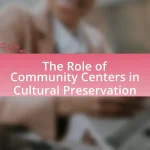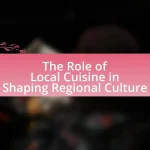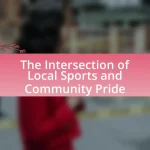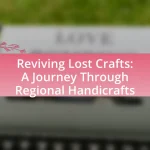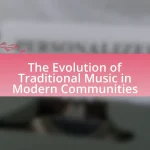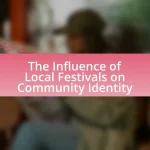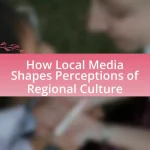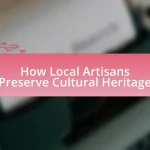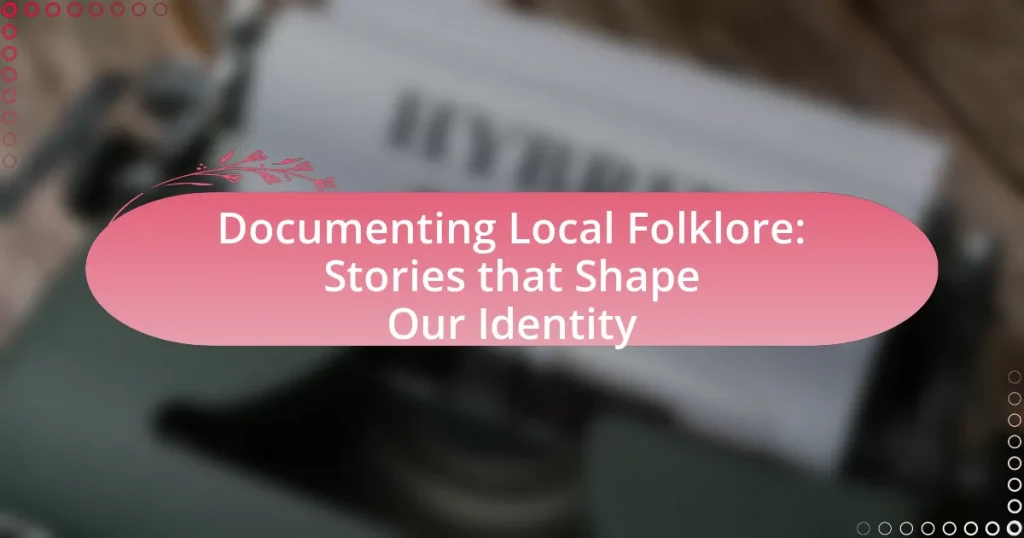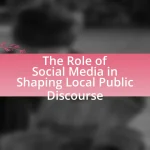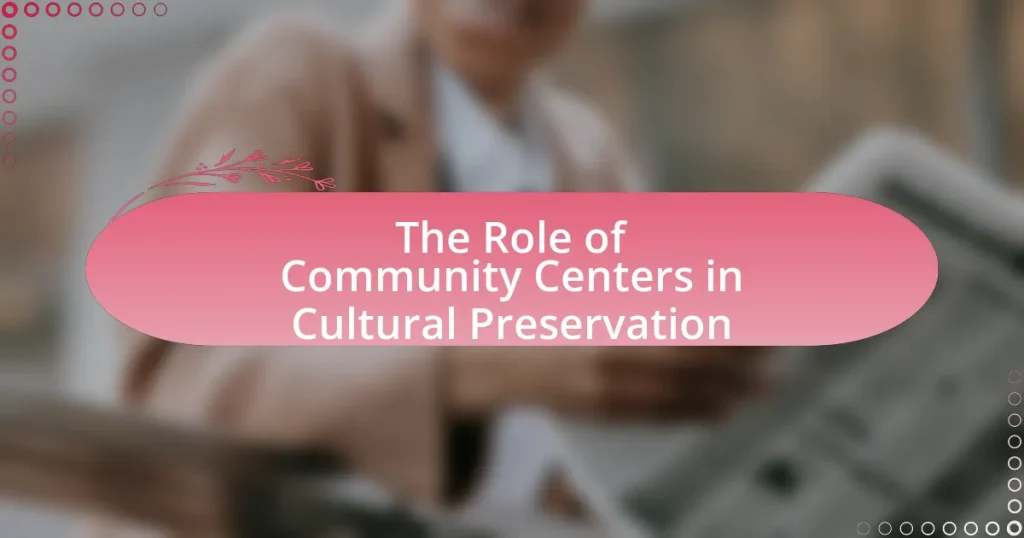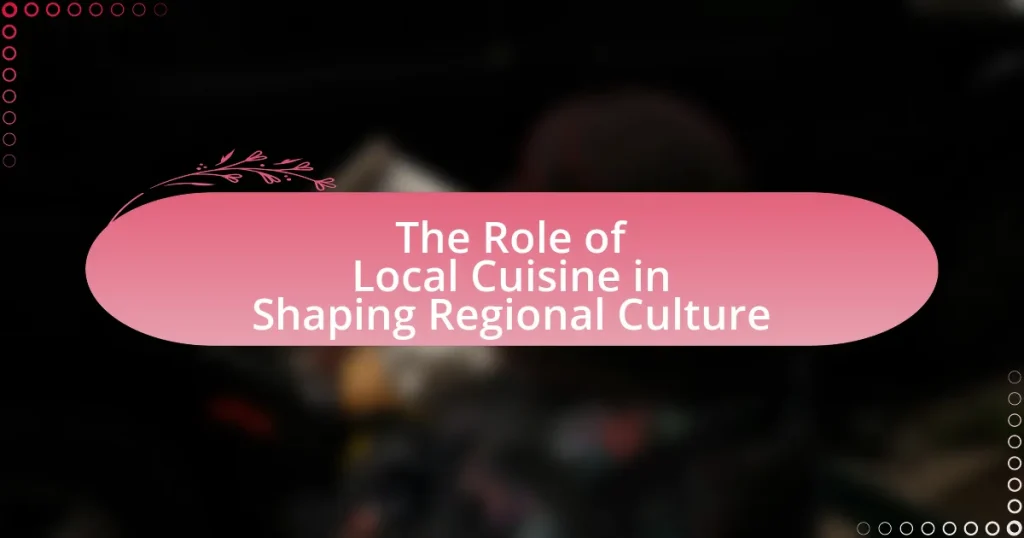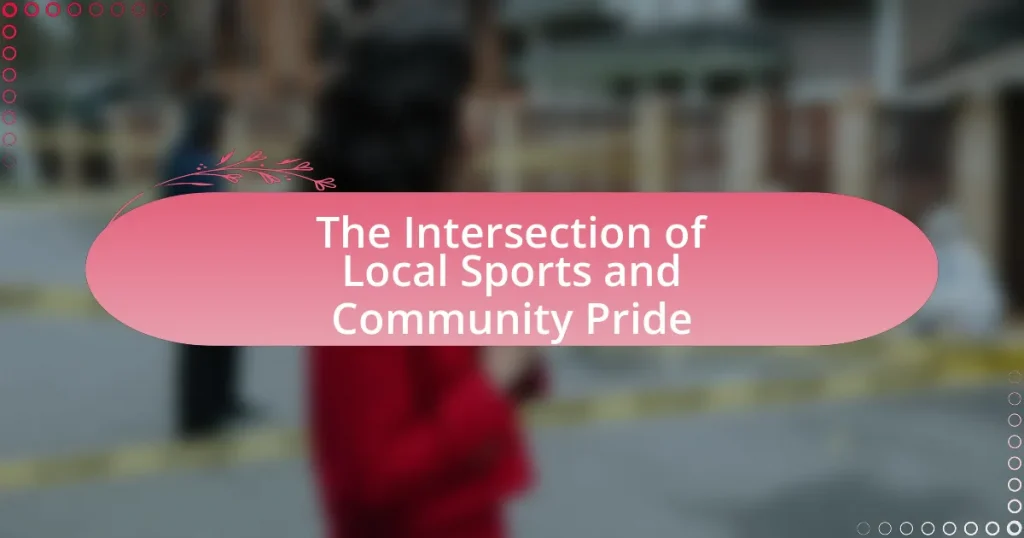Documenting local folklore is the systematic collection, preservation, and analysis of traditional stories, customs, and practices that define a community’s cultural identity. This process is vital for maintaining cultural heritage, fostering social cohesion, and enhancing community resilience. The article explores the significance of folklore in shaping cultural identity, the various forms it takes, and the methods used for effective documentation, including oral histories and multimedia recordings. It also addresses challenges such as cultural sensitivity and the loss of oral traditions, while highlighting best practices and ethical considerations for preserving these narratives.
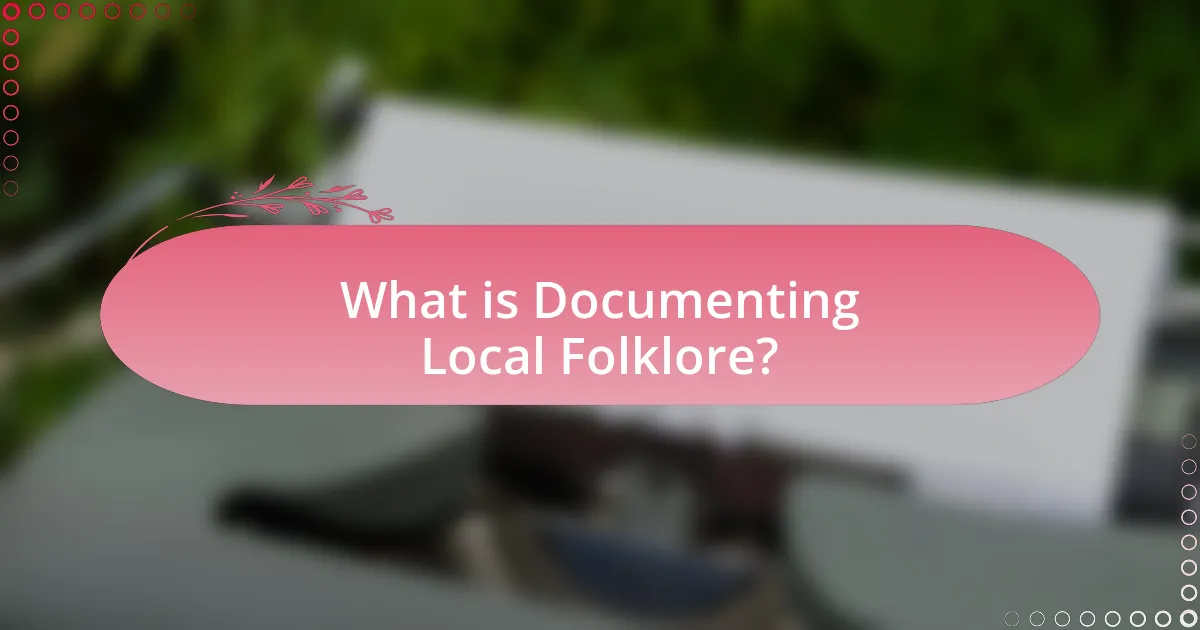
What is Documenting Local Folklore?
Documenting local folklore involves the systematic collection, preservation, and analysis of traditional stories, customs, and practices that characterize a specific community. This process is essential for understanding cultural identity and heritage, as it captures the unique narratives that shape a community’s values and beliefs. For instance, the American Folklife Center at the Library of Congress actively documents folklore through oral histories, ensuring that diverse cultural expressions are recorded and accessible for future generations.
Why is documenting local folklore important for communities?
Documenting local folklore is important for communities because it preserves cultural heritage and fosters a sense of identity. By recording stories, traditions, and practices, communities maintain a connection to their history and values, which can enhance social cohesion. Research indicates that communities with strong cultural narratives experience greater resilience and unity, as these stories often reflect shared experiences and collective memory. For instance, the National Endowment for the Arts highlights that folklore documentation can promote understanding and appreciation of diverse cultural backgrounds, thereby enriching community life.
How does folklore contribute to cultural identity?
Folklore contributes to cultural identity by preserving and transmitting the values, beliefs, and traditions of a community. This transmission occurs through stories, myths, and rituals that reflect the historical experiences and social norms of a group. For instance, the oral traditions of Indigenous peoples often encapsulate their relationship with the land, shaping their identity and worldview. Research indicates that communities with strong folklore traditions exhibit a greater sense of belonging and continuity, as these narratives reinforce shared heritage and collective memory.
What role does storytelling play in preserving history?
Storytelling plays a crucial role in preserving history by transmitting cultural knowledge and experiences across generations. Through narratives, communities share their values, traditions, and significant events, ensuring that historical context is maintained. For example, oral traditions in Indigenous cultures have preserved their histories and identities for thousands of years, as seen in the storytelling practices of the Navajo Nation, which convey their creation stories and historical events. This method of preservation not only keeps history alive but also fosters a sense of belonging and identity within communities.
What are the different forms of local folklore?
Local folklore manifests in various forms, including oral traditions, myths, legends, folktales, songs, dances, and rituals. Oral traditions serve as a primary means of passing down stories and cultural practices, while myths often explain natural phenomena or cultural beliefs. Legends typically recount historical events or figures, albeit with embellishments, and folktales convey moral lessons through fictional narratives. Songs and dances are integral to community celebrations and rituals, reflecting cultural identity and heritage. Each of these forms contributes to the preservation and expression of local culture, reinforcing community bonds and shared values.
How do myths and legends differ from folktales?
Myths and legends differ from folktales primarily in their cultural significance and narrative structure. Myths are traditional stories that explain natural phenomena, human behavior, or the origins of a culture, often involving deities or supernatural beings, such as the Greek myth of Prometheus, who stole fire from the gods. Legends, on the other hand, are narratives that are rooted in historical events or figures but are embellished over time, like the tale of King Arthur, which blends historical elements with fantastical aspects. Folktales, in contrast, are simpler stories that often convey moral lessons or entertain, such as the tale of Little Red Riding Hood, and do not typically involve the same level of cultural or historical significance as myths and legends.
What are the characteristics of oral traditions?
Oral traditions are characterized by their reliance on spoken word, cultural transmission, and communal participation. These traditions often include storytelling, songs, and rituals that are passed down through generations, preserving cultural identity and history. They are typically dynamic, allowing for adaptation and variation over time, reflecting the community’s values and experiences. Additionally, oral traditions often emphasize memory and performance, relying on the storyteller’s ability to engage the audience and convey meaning through expression and context. This method of sharing knowledge fosters a sense of belonging and continuity within the community.

How can we effectively document local folklore?
To effectively document local folklore, one should utilize a combination of oral history interviews, written narratives, and multimedia recordings. Oral history interviews allow for the collection of firsthand accounts from community members, preserving their unique perspectives and storytelling styles. Written narratives can be compiled from these interviews and supplemented with historical context, ensuring that the folklore is accurately represented. Multimedia recordings, including audio and video, capture the nuances of performance and expression, adding depth to the documentation. Research indicates that engaging with local communities and respecting their cultural practices enhances the authenticity and richness of the folklore being documented.
What methods are used to collect folklore stories?
Methods used to collect folklore stories include oral interviews, participant observation, and archival research. Oral interviews involve engaging with community members to record their narratives, often using audio or video equipment to ensure accuracy. Participant observation allows researchers to immerse themselves in the community, gaining insights into cultural practices and storytelling contexts. Archival research involves examining historical documents, manuscripts, and previous folklore collections to gather existing stories and contextual information. These methods are validated by their widespread use in ethnographic studies, as seen in works like “The Study of American Folklore” by Jan Harold Brunvand, which emphasizes the importance of firsthand accounts and community engagement in folklore documentation.
How can interviews be structured to gather rich narratives?
Interviews can be structured to gather rich narratives by employing open-ended questions that encourage detailed responses and personal storytelling. This approach allows interviewees to share their experiences and perspectives in depth, fostering a more engaging dialogue. For instance, starting with broad questions like “Can you describe a significant event from your childhood?” invites expansive answers, while follow-up prompts can delve deeper into specific aspects of their stories. Research indicates that narrative interviews, which prioritize the interviewee’s voice and context, yield more comprehensive and meaningful accounts (Squire, 2008, “Narrative Research in Psychology”). By creating a comfortable environment and actively listening, interviewers can elicit richer narratives that reflect the complexities of individual experiences.
What tools and technologies assist in documenting folklore?
Digital recording devices, such as audio recorders and video cameras, assist in documenting folklore by capturing oral traditions and performances in their original form. These tools enable researchers and enthusiasts to preserve stories, songs, and rituals accurately, ensuring that nuances of delivery and context are maintained. Additionally, software applications for transcription and analysis, like Otter.ai and ELAN, facilitate the organization and study of recorded materials, allowing for easier access and interpretation of folklore content. Furthermore, online platforms and databases, such as the American Folklife Center’s digital collections, provide repositories for sharing and archiving folklore, making it accessible to a broader audience and supporting collaborative documentation efforts.
How can communities engage in the documentation process?
Communities can engage in the documentation process by organizing local storytelling events and workshops that encourage residents to share their folklore. These events can be facilitated by local cultural organizations or schools, which can provide a structured environment for participants to narrate their stories. Research indicates that community-driven documentation efforts, such as those highlighted in the “Community Archives, Community Spaces” report by Jenny Bunn and Sue McKemmish, show that active participation fosters a sense of ownership and pride in local heritage. By utilizing digital tools, such as social media and community websites, communities can further disseminate and preserve these stories, ensuring they are accessible for future generations.
What role do local schools and organizations play?
Local schools and organizations play a crucial role in documenting local folklore by serving as platforms for cultural education and community engagement. They facilitate the collection, preservation, and sharing of local stories, traditions, and practices, which are essential for maintaining cultural identity. For instance, schools often incorporate local folklore into their curricula, allowing students to learn about their heritage and fostering a sense of belonging. Organizations, such as cultural centers or historical societies, actively organize events, workshops, and storytelling sessions that encourage community participation and the transmission of folklore across generations. This collaborative effort not only enriches the community’s cultural landscape but also strengthens social bonds, as evidenced by various studies highlighting the positive impact of community engagement on cultural preservation.
How can social media be utilized to share folklore?
Social media can be utilized to share folklore by providing platforms for storytelling, visual content, and community engagement. These platforms, such as Facebook, Instagram, and TikTok, allow users to post narratives, images, and videos that capture local traditions and legends. For instance, the hashtag #FolkloreFriday on Twitter encourages users to share folklore stories, fostering a sense of community and cultural exchange. Additionally, social media enables the preservation of folklore by allowing users to document and archive stories, making them accessible to a global audience. This democratization of storytelling helps to maintain cultural heritage and encourages intergenerational sharing, as younger audiences engage with traditional narratives in contemporary formats.
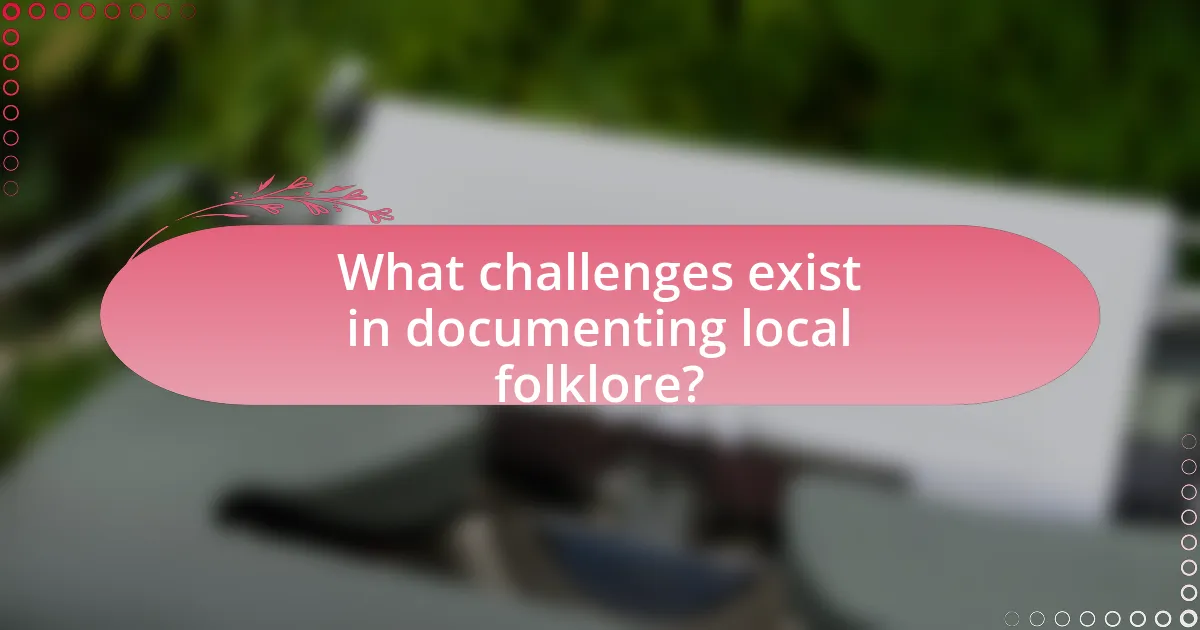
What challenges exist in documenting local folklore?
Documenting local folklore faces several challenges, including the ephemeral nature of oral traditions, cultural sensitivity, and the potential for misrepresentation. Oral traditions are often passed down verbally, leading to variations and loss of authenticity over time, as evidenced by studies showing that oral narratives can change significantly with each retelling. Cultural sensitivity is crucial, as some folklore may be sacred or private, making it difficult to document without offending the community. Additionally, misrepresentation can occur when outsiders interpret folklore without understanding its cultural context, which can distort the original meaning and significance. These challenges highlight the complexities involved in accurately capturing and preserving local folklore.
What are the common obstacles faced by folklorists?
Folklorists commonly face obstacles such as limited funding, access to communities, and the challenge of preserving oral traditions. Limited funding restricts their ability to conduct extensive fieldwork and document folklore effectively. Access to communities can be hindered by language barriers, mistrust, or cultural differences, making it difficult for folklorists to engage with informants. Additionally, the challenge of preserving oral traditions arises from the decline of storytelling practices in modern society, which threatens the transmission of cultural heritage. These obstacles significantly impact the ability of folklorists to document and analyze local folklore, ultimately affecting the preservation of cultural identities.
How does cultural appropriation affect folklore documentation?
Cultural appropriation negatively impacts folklore documentation by distorting the original narratives and erasing the cultural context from which they originate. When elements of a culture are appropriated without understanding or respect, the authenticity of folklore is compromised, leading to misrepresentation and oversimplification of complex cultural stories. For instance, the appropriation of Native American stories by non-Native individuals often strips these tales of their spiritual significance and communal ties, resulting in a loss of cultural heritage. This distortion can hinder the accurate preservation and transmission of folklore, as it may prioritize commercialized or sensationalized versions over genuine cultural expressions.
What issues arise from the loss of oral traditions?
The loss of oral traditions leads to a significant erosion of cultural identity and communal knowledge. When oral traditions are lost, communities experience a disconnection from their history, values, and shared experiences, which are often conveyed through storytelling. This disconnection can result in a diminished sense of belonging and cultural continuity, as seen in various indigenous populations where oral narratives play a crucial role in maintaining social cohesion and cultural heritage. Furthermore, the absence of these traditions can lead to the loss of unique languages and dialects, as many oral traditions are tied to specific linguistic expressions. Studies have shown that communities with rich oral traditions often have stronger social bonds and resilience, highlighting the importance of preserving these narratives for future generations.
How can these challenges be overcome?
To overcome the challenges of documenting local folklore, communities can implement collaborative storytelling initiatives that engage local residents in sharing their narratives. By organizing workshops and events that encourage participation, communities can gather diverse stories that reflect their cultural heritage. Research indicates that participatory approaches enhance community engagement and preserve folklore effectively, as seen in projects like the “Folklore in the Digital Age” initiative, which successfully documented over 500 local stories through community involvement. This method not only fosters a sense of ownership among participants but also ensures that the collected folklore accurately represents the community’s identity.
What strategies can be implemented to protect folklore?
To protect folklore, strategies such as documentation, community engagement, and legal protection can be implemented. Documentation involves recording oral traditions, stories, and practices through written, audio, or visual means, ensuring that these cultural expressions are preserved for future generations. Community engagement fosters local participation in preserving folklore by encouraging storytelling events, workshops, and cultural festivals, which strengthen communal ties and raise awareness about the importance of folklore. Legal protection, such as copyright and intellectual property rights, can safeguard traditional knowledge and expressions from exploitation, ensuring that communities retain control over their cultural heritage. These strategies collectively contribute to the preservation and appreciation of folklore, reinforcing its significance in shaping cultural identity.
How can collaboration enhance folklore documentation efforts?
Collaboration can enhance folklore documentation efforts by pooling diverse perspectives and resources, leading to a more comprehensive and accurate representation of cultural narratives. When individuals from various backgrounds, such as local community members, scholars, and cultural organizations, work together, they can share knowledge, access different storytelling techniques, and utilize varied documentation methods. For instance, a study by the Smithsonian Institution highlights that collaborative projects often result in richer data collection and preservation, as they engage multiple voices and experiences, thereby capturing the nuances of folklore that might be overlooked in isolated efforts. This collective approach not only strengthens the documentation process but also fosters community engagement and ownership of cultural heritage.
What are best practices for documenting local folklore?
Best practices for documenting local folklore include conducting thorough interviews with community members, recording oral histories, and collecting artifacts related to the folklore. Engaging with local storytellers ensures authenticity and depth, while audio and video recordings preserve the nuances of storytelling. Additionally, maintaining detailed field notes that capture context, settings, and participant reactions enhances the documentation process. Research indicates that participatory methods, where community members are involved in the documentation process, lead to richer and more accurate representations of folklore (Smith, 2016, “Community Engagement in Folklore Documentation,” Journal of Folklore Studies).
How can ethical considerations guide the documentation process?
Ethical considerations can guide the documentation process by ensuring respect for the cultural significance and ownership of local folklore. This involves obtaining informed consent from storytellers and communities, which acknowledges their rights and contributions. For instance, the American Folklife Center emphasizes the importance of ethical practices in folklore documentation, highlighting that respecting the wishes of the community fosters trust and encourages participation. Additionally, ethical guidelines advocate for accurate representation, preventing misinterpretation or exploitation of cultural narratives, thereby preserving the integrity of the stories that shape community identity.
What tips can help ensure the accuracy of folklore stories?
To ensure the accuracy of folklore stories, it is essential to cross-reference multiple sources. This involves gathering accounts from various storytellers, written records, and historical documents to identify common themes and discrepancies. For instance, comparing versions of a tale from different regions can highlight variations that may indicate cultural influences or historical changes. Additionally, engaging with local historians or cultural experts can provide context and validate the authenticity of the stories. Research shows that oral traditions can evolve over time, so documenting the storytelling process and noting the storyteller’s background can also enhance accuracy.
